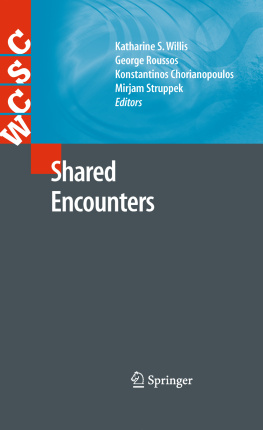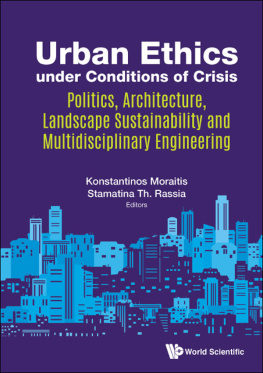Katharine S. Willis George Roussos Konstantinos - Shared Encounters
Here you can read online Katharine S. Willis George Roussos Konstantinos - Shared Encounters full text of the book (entire story) in english for free. Download pdf and epub, get meaning, cover and reviews about this ebook. City: London, publisher: Springer London, genre: Politics. Description of the work, (preface) as well as reviews are available. Best literature library LitArk.com created for fans of good reading and offers a wide selection of genres:
Romance novel
Science fiction
Adventure
Detective
Science
History
Home and family
Prose
Art
Politics
Computer
Non-fiction
Religion
Business
Children
Humor
Choose a favorite category and find really read worthwhile books. Enjoy immersion in the world of imagination, feel the emotions of the characters or learn something new for yourself, make an fascinating discovery.
- Book:Shared Encounters
- Author:
- Publisher:Springer London
- Genre:
- City:London
- Rating:5 / 5
- Favourites:Add to favourites
- Your mark:
- 100
- 1
- 2
- 3
- 4
- 5
Shared Encounters: summary, description and annotation
We offer to read an annotation, description, summary or preface (depends on what the author of the book "Shared Encounters" wrote himself). If you haven't found the necessary information about the book — write in the comments, we will try to find it.
Shared Encounters — read online for free the complete book (whole text) full work
Below is the text of the book, divided by pages. System saving the place of the last page read, allows you to conveniently read the book "Shared Encounters" online for free, without having to search again every time where you left off. Put a bookmark, and you can go to the page where you finished reading at any time.
Font size:
Interval:
Bookmark:
Sharing Experience
Katharine S. Willis1  , George Roussos, Konstantinos Chorianopoulos and Mirjam Struppek
, George Roussos, Konstantinos Chorianopoulos and Mirjam Struppek
| (1) | Locating Media Graduate School, US 236, University of Siegen, 57072 Siegen, Germany |
The approach often adopted by Human Computer Interaction (HCI) focuses on exchanges between a person and the interface of a device situated within a specific context of use. This view is increasingly challenged by the complex and dynamic world of the physical and social environment integrated with ubiquitous technologies, which requires an alternative view that sees people creating settings which frame and structure their encounters. As a result, in recent years, HCI researchers have recognized the need for social and physical data to be gathered and interpreted, but have often been frustrated in their attempts to codify and make sense of the complex and dynamic nature of the real world of human experience. Developments in the early 90s such as the emergence of the field of Computer Supported Cooperative Work (CSCW), the introduction of the concept of social navigation (Hook et al. ) have all lead the way to a new understanding of HCI.
Another driver for this change in emphasis in HCI is the emergence of mobile and ubiquitous computing that has brought significant changes in social and cultural practices in spatial settings. Interactions through and with ubiquitous technologies no longer require physical co-presence and have broadened the range of possible interactions as well as the range of settings in which these interactions can unfold. The basis for this lies in the fact that physical distance no longer prevents many of the types of interactions and encounters that had previously been confined to face-to-face contact. As a result, there has been much discussion on the role of spatial setting and interaction mediated through technologies such as that on the role of space and agency in the quality of the interaction (Dourish and Harrisson ) which explore interactions through realization have been developed. These projects and research offer many useful insights, but there still remain many questions about how to create the conditions for meaningful and persisting shared interactions in public space. The challenge is not only to build systems that respond to rich and dynamic social and physical events, but also to provide a structure for sustainable participation and sharing.
If we are to design for such changes in social practice then we need to understand them in the actual context in which they occur in everyday life. Methodologies, particularly ethnographic studies, have started to become popular means by which one can analyze the qualitative as well as the quantitative aspects of user behavior and interaction in everyday settings (e.g., Ito et al. ). Yet, several challenges lie ahead before it is possible to fully capture and interpret the multiple and diverse interactions of people on the move in urban places. We believe that to address these challenges, it is necessary to build on contributions from fields outside of HCI to inform both theoretical and empirical work; with sociology, architecture, anthropology, and urban planning providing valuable perspectives that can offer us new insights and solutions.
In this chapter, we address the topic of shared encounters in two stages; first by discussing in depth the characteristics and features of shared encounters and how they are enacted in our everyday lives. The second half of the chapter then focuses on reviewing appropriate methodologies for the study of shared encounters in public space.
The topic of shared encounters derives from the conversations at the Shared Encounters workshop held as part of CHI 2007 (Willis et al. ). In our discussions during the workshop, we investigated the nature of interaction in public space as mediated through new technologies and in particular we questioned what is the glue that creates links between people in public spaces? Interestingly, it turned out that one of the most provocative questions during the workshop was the most obvious; what constitutes a shared encounter and what sets it apart from other experiences? In particular, when does an interaction between a person and another or between members of a group become a shared encounter? A further core question was to identify the ways in which the physical setting affects the nature of an encounter.
Font size:
Interval:
Bookmark:
Similar books «Shared Encounters»
Look at similar books to Shared Encounters. We have selected literature similar in name and meaning in the hope of providing readers with more options to find new, interesting, not yet read works.
Discussion, reviews of the book Shared Encounters and just readers' own opinions. Leave your comments, write what you think about the work, its meaning or the main characters. Specify what exactly you liked and what you didn't like, and why you think so.








